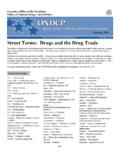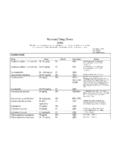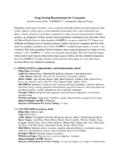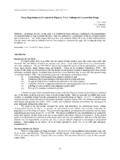Transcription of Drug-Induced Hematologic Disorders Kamakshi V. …
1 Drug-Induced Hematologic Disorders Kamakshi V. Rao KeY COnCePTS. 1 The most common Drug-Induced Hematologic Disorders include aplastic anemia, agranulocytosis, megaloblastic e|CHAPTER 24. Although Drug-Induced Hematologic Disorders are less com- mon than other types of adverse reactions, they are associated with anemia, hemolytic anemia, and thrombocytopenia. significant morbidity and mortality. An epidemiologic study con- 2 Drug-Induced Hematologic Disorders are generally rare ducted in the United States estimated that 4,490 deaths in 1984 were adverse effects associated with drug therapy. attributable to blood dyscrasias from all causes. Aplastic anemia was the leading cause of death followed by thrombocytopenia, agranulo- 3 reporting during postmarketing surveillance of a drug is cytosis, and hemolytic Similar to most other adverse drug usually the method by which the incidence of rare adverse reactions, Drug-Induced Hematologic Disorders are more common in drug reactions is established.
2 Elderly adults than in the young; the risk of death also appears to be 4 Because Drug-Induced blood Disorders are potentially greater with increasing age. dangerous, rechallenging a patient with a suspected 3 Because of the seriousness of Drug-Induced Hematologic agent in an attempt to confirm a diagnosis is not generally Disorders , it is necessary to track the development of these Disorders recommended. to predict their occurrence and to estimate their incidence. Report- 5 The mechanisms of Drug-Induced Hematologic Disorders ing during postmarketing surveillance of a drug is the most com- can be the result of either direct drug or metabolite toxicity mon method of establishing the incidence of adverse drug reactions. or an immune reaction. The MedWatch program supported by the Food and drug Admin- istration is one such Many facilities have similar drug - 6 The primary treatment of Drug-Induced Hematologic reporting programs to follow adverse drug reaction trends and to Disorders is removal of the drug in question and determine whether an association between a drug and an adverse symptomatic support of the patient.
3 drug reaction is causal or coincidental. In the case of Drug-Induced Hematologic Disorders , these programs can enable practitioners to confirm that an adverse event is indeed the result of drug therapy INTRODUCTION rather than one of many other potential causes; general guidelines are readily ,7. 1 Hematologic Disorders have long been a potential risk of modern 4 Because Drug-Induced blood Disorders are potentially dan- pharmacotherapy. Granulocytopenia (agranulocytosis) was reported gerous, rechallenging a patient with a suspected agent in an attempt in association with one of medicine's early therapeutic agents, sul- to confirm a diagnosis is not recommended. In vitro studies with fanilamide, in Some agents cause predictable Hematologic the offending agent and cells or plasma from the patient's blood disease ( , antineoplastics), but others induce idiosyncratic reac- can be performed to determine These methods are often tions not directly related to the drugs' pharmacology.
4 The most expensive, however, and require facilities and expertise that are not common Drug-Induced Hematologic Disorders include aplastic ane- generally available. Laboratory confirmation of drug causation is mia, agranulocytosis, megaloblastic anemia, hemolytic anemia, and not always necessary to warrant interruption or discontinuation of thrombocytopenia. therapy. Therefore, it is extremely important that practitioners be 2 The incidence of idiosyncratic Drug-Induced Hematologic able to clinically evaluate suspect drugs quickly and to interrupt Disorders varies depending on the condition and the associated drug . therapy when necessary. Few epidemiologic studies have evaluated the actual incidence Throughout the past decades, lists of drugs that have been asso- of these adverse reactions, but these reactions appear to be rare.
5 Ciated with adverse events have been developed to help clinicians Women are generally more susceptible than men to the Hematologic identify possible causes. Unfortunately, these lists are extremely effects of drugs. The incidence varies based on geography, which extensive, including a large number of very commonly used drugs, suggests that genetic differences may be important determinants of making it difficult to determine the cause of any abnormality. Fur- susceptibility. Drug-Induced thrombocytopenia is the most common thermore, the absence of a drug from such a list should not discour- Drug-Induced Hematologic Disorders , with some reports suggesting age the investigation and reporting of an agent associated with an that as many as 5% of patients who receive heparin develop heparin- adverse event.
6 It is imperative that clinicians use a rational approach induced The Berlin Case-Control Surveillance to determine causality and identify the agents associated with a reac- Study was conducted from 2000 to 2009 to assess the incidence and tion. The clinician should focus on the issue, perform a rigorous risks of Drug-Induced Hematologic Disorders . This evaluation found investigation, develop appropriate criteria, use objective criteria to that almost 30% of all cases of blood dyscrasias were possibly grade the response, and complete a quantitative summary. A com- attributable to drug plete, thorough, and detailed drug and exposure history must be 359. Copyright 2014 McGraw-Hill Education. All rights reserved. 360. Bone marrow Blood Myeloblast Metamyelocyte Neutrophil SECTION.
7 Agranulocytosis 2 Stem cells Proerythroblast Late normoblast Red cell Organ-Specific Function Tests and Drug-Induced Diseases Hemolytic anemia Committed Megakaryoblast Megakaryocyte Platelets stem cells Thrombocytopenia Aplastic anemia eFIGURE 24-1 Differentiation of the stem cell into committed cell lines, illustrating the origins of various Drug-Induced Hematologic Disorders . obtained from the patient in order to best determine any potential for cells, which are also called progenitor cells or colony-forming cells. drug causation. A systematic approach to evaluate the information Committed to a particular cell line, these intermediate stem cells available in the literature also helps the clinician focus and intervene differentiate into colonies of each type of blood cell in response to in the cause of the disorder.
8 Specific colony-stimulating factors (eFig. 24-1). A common tool used by clinicians to rate the likelihood of Drug-Induced Hematologic Disorders can affect any cell line, causality in adverse drug reaction (ADR) investigations is an ADR including white blood cells (WBCs), red blood cells (RBCs), and probability scale (algorithm). One such scale was developed and platelets. When a drug causes decreases in all three cell lines accom- tested by Naranjo and This tool provides a series of panied by a hypoplastic bone marrow, the result is Drug-Induced scored questions that leads an investigator to the likelihood that an aplastic anemia. The decrease in WBC count alone by a medication ADR was caused by the suspected medication. Depending on the is Drug-Induced agranulocytosis.
9 Drugs can affect RBCs by caus- aggregate score, the causality is rated as doubtful, possible, prob- ing a number of different anemias, including Drug-Induced immune able, or definite. The scale gives the most weight to the temporal hemolytic anemia, Drug-Induced oxidative hemolytic anemia, or relationship of the reaction with relation to administration of the Drug-Induced megaloblastic anemia. A Drug-Induced decrease in drug , observations after a rechallenge of the suspected medica- platelet count is Drug-Induced thrombocytopenia. tion, and alternate explanations for the ADR. As mentioned earlier, it is often unethical to rechallenge patients who experience severe Hematologic toxicities. Thus, without a rechallenge, it is difficult to Drug-Induced . achieve a causality rating of definite with such an algorithm.
10 In determining the likelihood that an observed reaction is APLASTIC ANEMIA. caused by a particular medication, clinicians should review the Aplastic anemia is a rare, serious disease of unclear etiology. It medical literature for past reports supporting the observation. Using was first described by Ehrlich in 1888 after an episode of failed an evidence-based approach such as that proposed by Sackett,10 the hematopoiesis identified during the autopsy of a pregnant investigator assigns greater weight to prospective study designs such Since that first report, numerous cases of aplastic anemia have been as clinical trials or cohort studies than to case reports or expert opin- described, but the true incidence of the disease remains uncertain. ion. This provides a framework for the investigator's confidence in Drug-Induced aplastic anemia was initially reported in the 1930s, published literature describing ADRs.





